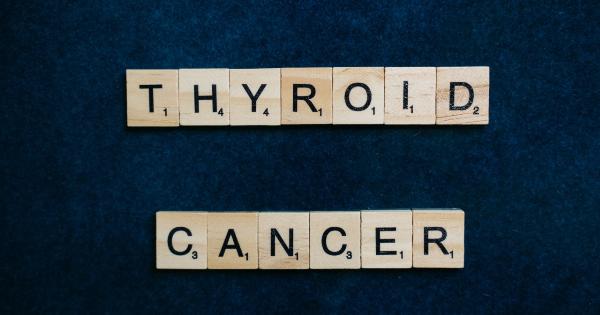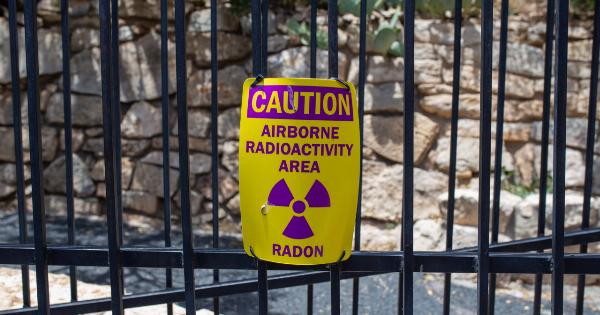Thyroid cancer is a type of cancer that affects the thyroid gland, a small butterfly-shaped gland located at the base of the neck. The thyroid gland is responsible for producing hormones that regulate the body’s metabolism.
When cancer cells form in the tissues of the thyroid gland, it can disrupt the normal functions of the gland and potentially spread to other parts of the body.
Types of Thyroid Cancer
There are several types of thyroid cancer, including:.
Papillary Thyroid Cancer
Papillary thyroid cancer is the most common type, accounting for about 80% of all thyroid cancer cases. It typically develops slowly and has a high cure rate, especially when detected early. It often affects people between the ages of 30 and 50.
Follicular Thyroid Cancer
Follicular thyroid cancer is the second most common type and accounts for about 10-15% of cases. It is more common among middle-aged and older adults.
Unlike papillary thyroid cancer, it tends to spread to other parts of the body, such as the lungs or bones.
Medullary Thyroid Cancer
Medullary thyroid cancer is less common and originates from the C cells of the thyroid gland. It can be hereditary and is often associated with other endocrine disorders. Early detection and treatment are crucial for managing this type of thyroid cancer.
Anaplastic Thyroid Cancer
Anaplastic thyroid cancer is rare but aggressive. It grows rapidly and is challenging to treat. It often affects older adults and spreads quickly to nearby tissues and organs.
Prompt medical attention is essential for this aggressive form of thyroid cancer.
Thyroid Lymphoma
Thyroid lymphoma is a rare type of thyroid cancer that starts in the immune cells of the thyroid. It is more common in people over the age of 60 and may present with symptoms like a rapidly growing neck mass and difficulty breathing or swallowing.
Causes and Risk Factors
The exact causes of thyroid cancer are not well understood. However, certain factors can increase the risk of developing this condition, including:.
Family History
Individuals with a family history of thyroid cancer or certain hereditary conditions, such as familial medullary thyroid cancer or familial adenomatous polyposis, have a higher risk of developing thyroid cancer.
Exposure to Radiation
Previous exposure to high levels of radiation, especially during childhood, increases the risk of developing thyroid cancer.
Gender
Thyroid cancer is more common in women than in men, although the reasons for this gender difference are not fully understood.
Age
Thyroid cancer can occur at any age, but it is more commonly diagnosed in people between the ages of 30 and 60.
Symptoms of Thyroid Cancer
In its early stages, thyroid cancer may not cause noticeable symptoms. However, as the cancer progresses, the following signs and symptoms may occur:.
Lump in the Neck
The most common symptom of thyroid cancer is a lump or swelling in the neck. This lump is typically painless but may cause discomfort or difficulty swallowing.
Changes in the Voice
Thyroid cancer can affect the nerves responsible for voice production, leading to hoarseness or other changes in the voice.
Swollen Lymph Nodes
Cancer cells may spread to the nearby lymph nodes, causing them to become enlarged and palpable.
Persistent Neck Pain
Some individuals with thyroid cancer may experience persistent pain in their neck that radiates to the ears.
Difficulty Swallowing or Breathing
As the tumor grows, it can put pressure on the esophagus or windpipe, resulting in difficulty swallowing or breathing.
Diagnosing Thyroid Cancer
If thyroid cancer is suspected, the following diagnostic tests may be performed:.
Physical Examination
A healthcare provider will perform a physical examination to check for any abnormalities in the thyroid gland, neck, and lymph nodes.
Medical History
The doctor will inquire about the patient’s medical history, including any family history of thyroid cancer or exposure to radiation.
Ultrasound
An ultrasound uses sound waves to create images of the thyroid gland and can help detect any abnormalities or suspicious nodules.
Biopsy
A biopsy involves removing a small sample of tissue from the thyroid gland or any suspicious nodules for examination under a microscope. This procedure confirms the presence of cancer and helps determine the specific type and stage.
Treatment Options
The treatment plan for thyroid cancer depends on various factors, including the type, stage, and individual patient characteristics. The main treatment options include:.
Surgery
Surgery is the most common and primary treatment for thyroid cancer. The goal is to remove as much of the cancerous tissue as possible.
The extent of surgery may vary from removing only a part of the thyroid gland (lobectomy) to removing the entire gland (total thyroidectomy). In some cases, nearby lymph nodes may also be removed.
Radioactive Iodine Therapy
After surgery, radioactive iodine therapy may be recommended to destroy any remaining thyroid tissue or cancer cells. The patient takes a radioactive iodine pill, and the radioactive iodine is absorbed by the thyroid cells, destroying them.
External Beam Radiation Therapy
External beam radiation therapy involves using high-energy X-rays to kill cancer cells. This treatment may be useful in advanced or recurrent thyroid cancer cases.
Thyroid Hormone Therapy
Patients may need to take thyroid hormone replacement medication for the rest of their lives after surgery to maintain the body’s metabolic functions. This medication helps replace the hormones that the thyroid gland would normally produce.
Chemotherapy
Chemotherapy is not commonly used for most types of thyroid cancer. However, it may be recommended in more advanced cases or for anaplastic thyroid cancer.
Follow-Up Care and Prognosis
After completing treatment, regular follow-up appointments will be necessary to monitor the patient’s condition and check for any signs of recurrence. The prognosis for thyroid cancer is generally good, especially when detected early.
The five-year survival rate is around 98.1%, but it can vary depending on the type and stage of cancer.
Thyroid Cancer Awareness
Thyroid cancer awareness is crucial for early detection, prompt treatment, and improved outcomes.
Education about the risk factors, symptoms, and available screening methods can help individuals recognize potential warning signs and seek medical attention promptly.
Protective Measures
While the exact cause of thyroid cancer is unknown, taking certain precautions may help reduce the risk:.
Limiting Radiation Exposure
Limit exposure to unnecessary radiation sources and ensure appropriate safety measures, especially during childhood and early adulthood.
Regular Self-Examination
Perform regular self-examinations of the neck, checking for any lumps, swelling, or other abnormalities.
Annual Physical Check-Ups
Attend annual check-ups with a healthcare provider who can perform a thorough examination of the thyroid gland and other relevant areas.
Conclusion
Thyroid cancer is a relatively uncommon form of cancer, but its prevalence has been increasing in recent years. Understanding the types, risk factors, and symptoms of thyroid cancer is essential for early detection and effective treatment.
By spreading awareness and promoting regular check-ups, we can improve the prognosis and outcomes for individuals affected by this disease.



























